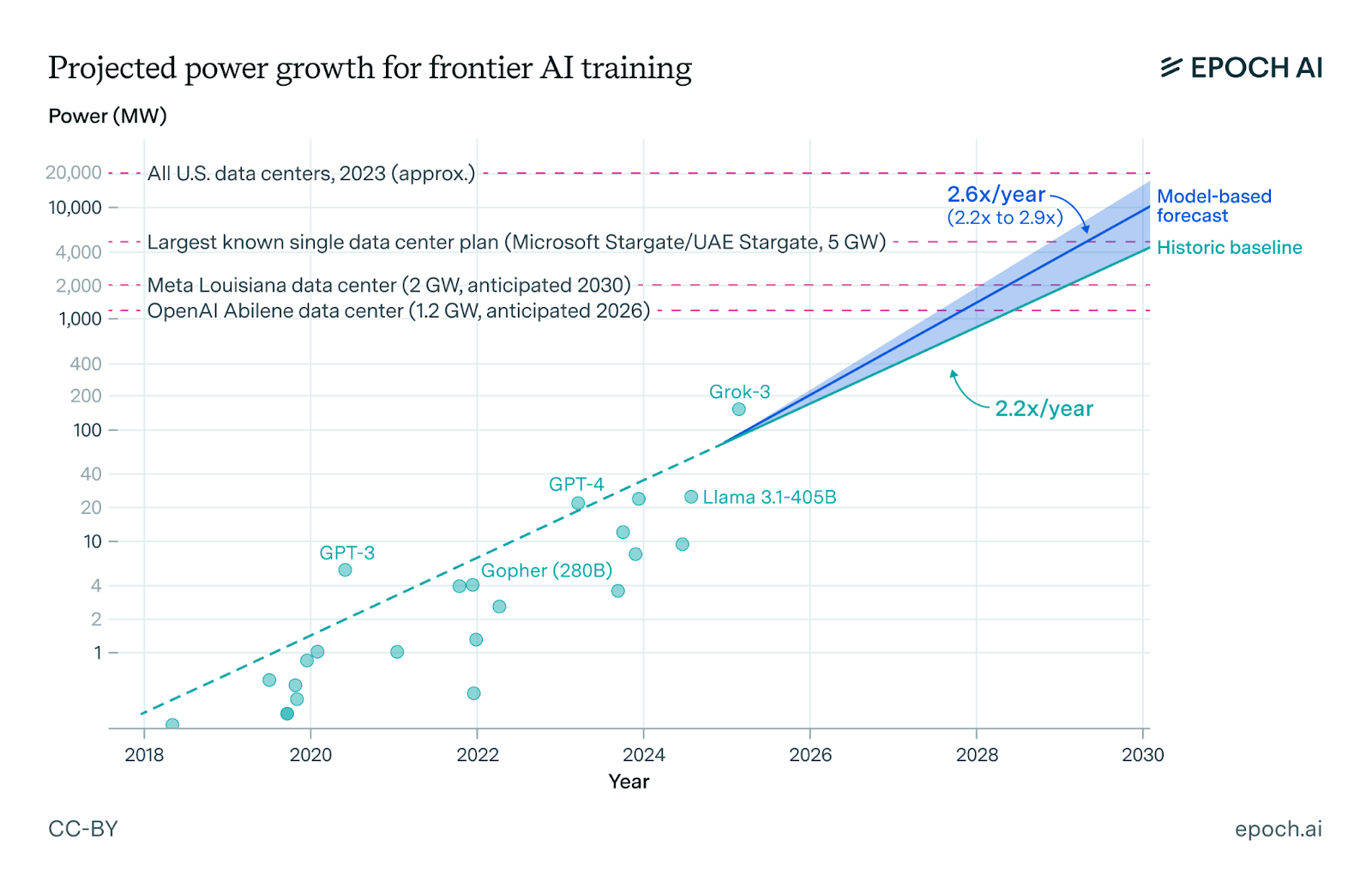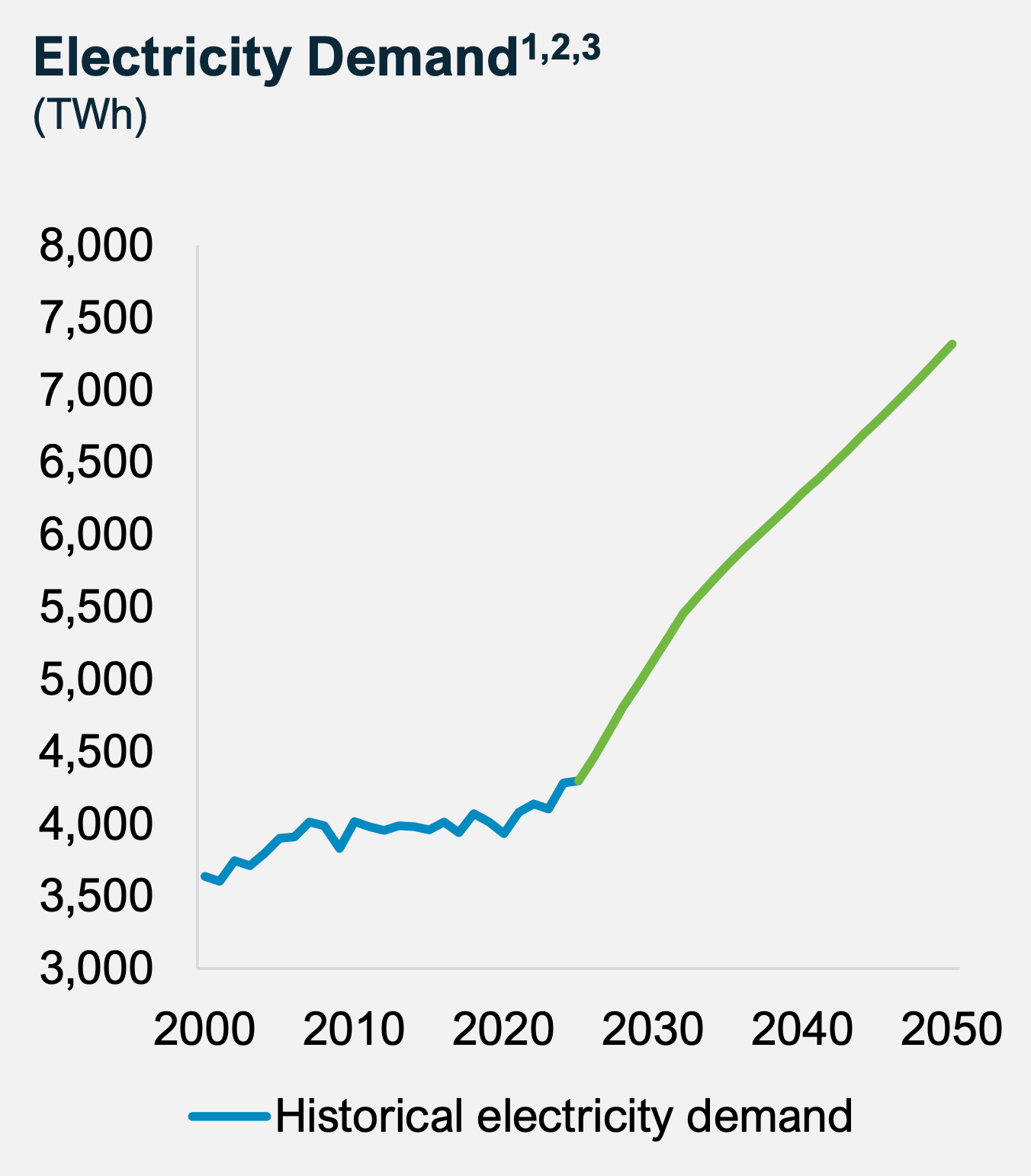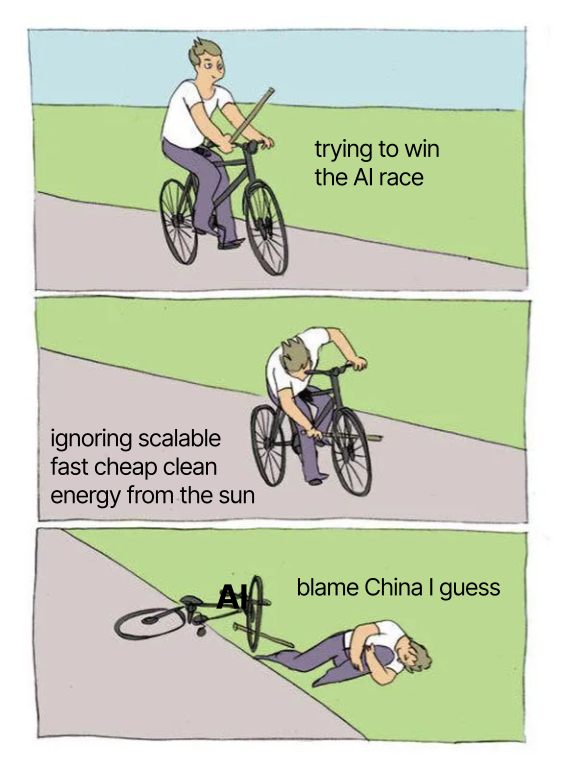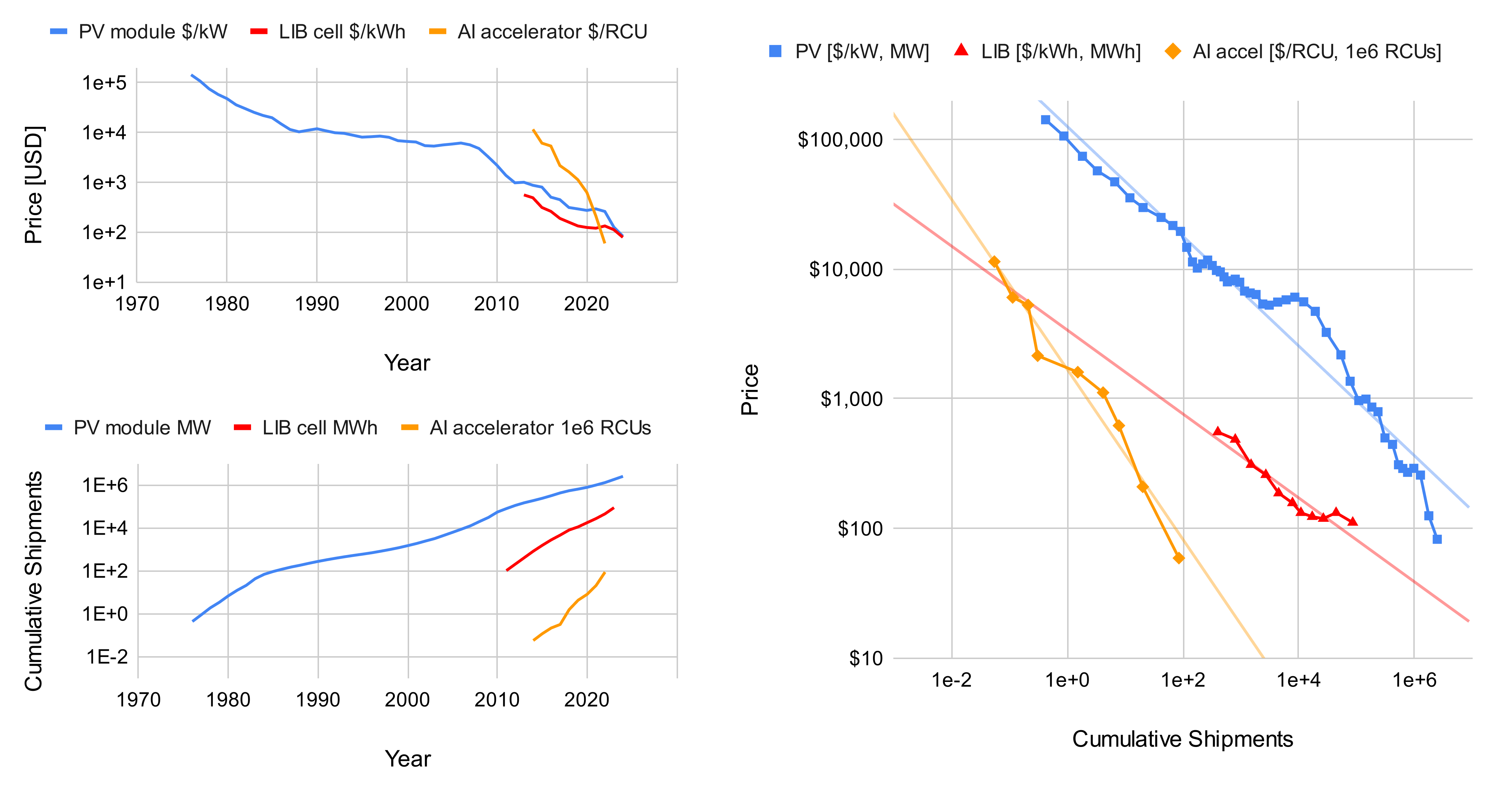This is the second of a two-part manifesto on why solar will power the age of artificial intelligence. Read Part 1 here.
—
The Sun powered the first intelligence on Earth—humans. Our 20W brains run on solar energy mediated by plants.
Now a new intelligence is coming.
Artificial general intelligence (AGI) may arrive as soon as 2030, with superintelligence (ASI) coming shortly thereafter. I believe it too will be—must be—solar powered. AGI will run on solar energy mediated by photovoltaics. Because when you light a fire that will never go out, you need a forever energy source.

AGI is going to be hungry. Training a single frontier AI model today burns ~100GWh, enough electricity to power 10,000 homes for a year. By 2030, a frontier training run could pull 10GW, up from 100MW today.

Training is a one-time cost measured in months and gigawatt-hours. But once AGI is deployed at scale, inference demand will dwarf training, and it will never stop. Imagine intelligent agents on every device. Billions of “unhobbled” AI systems learning, thinking, computer-using—working continuously, not just engaging in short dialogues via stream-of-consciousness.

Power is the biggest bottleneck for AI. Global data center energy demand will at least double to ~1,000TWh/yr by 2030. Add hundreds of gigafactories. Electric everything. Blackstone projects US electricity demand will rise 40% in the next decade.
And that may be an underestimate. OpenAI aims to scale up capacity by 125x (83% CAGR) and build 250GW of data centers by 2033. If Sam Altman delivers, that’s a single company consuming ~2,000TWh/yr—50% of current US electricity demand.

We need energy. We need it now. We need more tomorrow. And we need it clean—because powering superintelligence with coal and gas would be shortsighted and stupid at a civilizational scale. (Let’s not lower the bar for human-level intelligence.)
So how should we power AI with AGI on horizon? I propose 3 simple laws (à la Asimov):
Do no harm: AI infrastructure shall not harm humans or destabilize Earth’s climate.
—
If you’re building superintelligent systems that will scale indefinitely and consume untold amounts of energy in the future, the only prudent option is to power them with clean energy from the start.
AGI powered by fossil fuels would be an environmental disaster. Ruin the planet to unlock the future—not a good trade. AGI powered by clean energy could be neutral or even positive if it accelerates transmission buildout and clean energy deployment.
Clean energy is the only choice for AGI. That leaves hydro, nuclear, geothermal, wind, and solar on the table.
Follow human preferences: Within the bounds of Law 1, AI infrastructure shall be reliable, fast and cheap to deploy, and acceptable to most people.
—
In Part 1, we discussed how important a diverse generation mix is for meeting AI energy needs. Many energy technologies ranging from nuclear to firm solar (PV + storage/peakers) can power AI data centers reliably and at competitive cost (~$100/MWh).
Every clean energy source has a role to play—but not all are created equal.
Lead time (AKA “time to power” or “speed to power”) is by far the top priority for any hyperscaler or AI data center aficionado today. Power is the long pole in the tent for data center boot-up, so shorter lead times enable faster scaling and massively lower opportunity cost in a 40% CAGR market. Speed to power is critical for every player in the AI game.
How long does it take to build a power plant?
If we need power fast—and don’t have gas turbines on order already—solar PV wins.
(It’s worth noting that construction time stacks on top of interconnection time, which adds 4+ years in the US today. While every new power plant faces the interconnection queue, hundreds of GWs of solar PV and storage are “interconnection-ready” and just waiting to be built. See technical note.)

AGI means continuous inference at massive scale—not just occasional training runs. That requires compute infrastructure at scale, deployed near population centers to serve billions of users with low latency. Power plants near people must be clean and widely acceptable.
Most energy projects face NIMBYs. Wind farms have famously struggled with local opposition for years. Most Americans favor expanding nuclear power—but over 60% don’t want a new nuclear plant in their community. Fewer than half of Americans support more coal mining (41%), fracking (45%), or offshore drilling (48%).
Solar? People put it on their own roofs.
While utility-scale solar projects also face community pushback, solar PV has the highest public approval of any energy source. 77% of Americans favor more solar power, with majority support across demographics and political affiliations.
When asked about solar projects “in my community,” support stays at 89%. A 2023 LBNL survey of people living within 3 miles of solar projects found that positive attitudes outnumbered negative ones by a 3:1 ratio. People don't just support solar in theory—they want it near them.
Scale with AI: Within the bounds of Laws 1 and 2, AI infrastructure shall scale to enable continued AI progress.
—
Every major energy source—fossil or clean—is physically abundant enough to meet AI demand through 2030. A few hundred gigawatts of new load is massive and daunting for a constrained grid, yet it’s still only ~10% of global energy consumption.
But beyond 2030, all bets are off. Superintelligence is coming, and it’s the most exciting and scariest exponential in history. Can we build enough clean energy to match it?
AGI will demand terawatts—many, many terawatts.
Solar is by far the largest clean energy source, and one of the few that can scale from gigawatts to hundreds of terawatts. If AI is the next industrial revolution, then photons are the new oil—ubiquitous, inexhaustible, and getting cheaper the more we use it. Solar PV is the core of the AI infrastructure stack, and it will power the world sooner than most think.
Raw resource potential: The sun emits 4x1026 W and delivers less than 1 part per billion of its output to Earth (174,000TW)—and it’s still enough to power civilization 10,000 times over. Even with conservative conversion efficiencies and land coverage, solar PV offers orders of magnitude of headroom for humanity before we even need to think about space-based power.
Fusion is often pitched as infinite clean energy. Solar PV is fusion with free shipping and 8-minute delivery.

Land use: Solar needs a lot more land than nuclear—roughly 20x more land for the same annual energy output. (That’s what happens when your fusion reactor is 150 million kilometers away.) But the comparison is misleading, simply because we have So. Much. Sunlight. And PV can go almost anywhere the sun shines. Unlike other energy sources, solar PV can integrate seamlessly into the existing built environment—rooftops, parking lots, highways, reservoirs, canals, farmland, and more. We could power the entire US with solar using just the area devoted to coal mining.

And it gets even better. Next-generation perovskite tandem solar technology produces more power per area and will shrink land use by 30–50%.
Materials use: Solar panels are about 75% glass, which can be >90% recycled. Silicon (~5% of total mass) and CdTe (~1%) cells can be >95% recycled. Aluminum and steel frames (~10%) can be 100% recycled. We can already recover >90% of the materials in today’s silicon and thin-film modules. Unlike uranium mines or gas wells, a decommissioned solar farm can be recycled and rebuilt using mostly the same materials.
The actual constraints for solar are manufacturing capacity and grid integration—human problems, not physics problems.
PV supply chains are insanely concentrated today—over 80% of the world’s silicon feedstock, wafer, cell, and module production happens in China. China’s PV dominance will increasingly be a geopolitical chokepoint as solar becomes the dominant energy source for terrestrial and space power. The US, India, and others are racing to build GW-scale domestic factories and supply chains, recognizing that whoever controls advanced solar manufacturing controls the future of energy security and AI infrastructure.
Interconnection queues are another serious bottleneck. But grids will be upgraded, increased storage will mitigate intermittency, and behind-the-meter power reduces interconnection requirements.
AI economics hinge on the marginal cost per kWh. Inference is already the most expensive part of deploying AI (up to 90% of total cost), and electricity is the largest component of data center opex (~50%). Cheap electricity is a key moat.
Whoever controls the cheapest electrons will control the future of AI.
Solar is the cheapest electricity humans have ever invented. Utility-scale PV and wind are the lowest-cost forms of new-build energy generation without subsidies today. Solar has already won the race for daytime power—even the world’s most notorious underestimator of solar agrees. Energy storage unlocks more solar and is getting dramatically cheaper, fast. Solar + storage is on track to dominate the power sector in the coming decade. By 2033, solar will overtake nuclear, wind, hydro, gas, and coal to become the world's largest source of electricity.
And the cost advantage of solar and storage will only grow. Why?
Solar PV, battery storage, and AI compute all follow Wright's Law—for every doubling of cumulative production, prices fall by a fixed percentage. As we make more, we get better at making them:

Both solar and storage have decades of cost decline ahead.
Silicon PV efficiency is approaching its theoretical ceiling (29.5%), but perovskite-silicon tandems are breaking through with lab cell efficiencies above 34% and a path to over 40%. As silicon plateaus, tandems are just beginning their learning curve (and coming to market soon).
Battery performance also shows no signs of slowing. New chemistries (LFP, sodium-ion, solid-state) are improving energy densities, expanding supply chains, and accelerating cost reductions.
This is the advantage of mass-produced technology. It’s hard to “learn” when building complex and customized systems like nuclear plants. Large bespoke projects make it expensive and slow to experiment, which slows learning-by-doing and technological progress. But we can engineer better solar cells, design more energy-dense batteries, and manufacture billions of copies in ever larger and more automated factories. So the costdown continues.

This is a reinforcing cycle with no finish line in sight—the scale and cost gap between modular and bespoke technologies will widen every year as solar and storage continue down their learning curves. AI supercharges solar and storage R&D, making the technologies better and cheaper, unlocking more power for AI—and accelerating the growth of all three.
Solar, storage, and AI are three industries riding down exponential cost curves at massive scale. AGI will be powered by sunlight because when exponentials align—explosive AI demand meets falling solar and storage costs—the outcome is inevitable.
We’ve unlocked infinite energy just in time for infinite intelligence.
It feels like cosmic timing that humanity developed ultra-cheap solar power just as AI started ramping to planetary scale. When GPT-7-AGI starts sucking up gigawatts and spitting out tokens, one energy source will be ready—the one already deploying faster and cheaper than any other. The fastest-growing energy demand will be fueled by the fastest-growing energy source.

Solar-powered AGI is inevitable. The first superintelligence won’t run on oil, gas, or coal—it will run on sunlight. Hyperscalers that master solar will scale fastest, because solar is the only energy source that can truly dance with AI.
